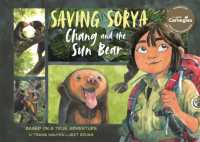Full Description
How can today's educators teach academic content to students with moderate and severe developmental disabilities - while helping all students meet Common Core State Standards? This text has answers for K-12 teachers, straight from 37 experts in special and general education. A followup to the landmark bestseller Teaching Language Arts, Math, and Science to Students with Significant Cognitive Disabilities, this important text prepares teachers to ensure more inclusion, more advanced academic content, and more meaningful learning for their students. Teachers will have the cutting-edge research and recommended practices they need to identify and deliver grade-aligned instructional content - leading to more opportunities and better quality of life for students with severe disabilities.
Prepare Teachers To:
skillfully adapt lessons in language arts, math, and science for students with disabilities
align instruction with Common Core State Standards
select target skills and goals
differentiate instruction using appropriate supports and assistive technologies
balance academic goals and functional skills
make the most of effective instructional procedures such as peer tutoring, cooperative learning, and co-teaching
maintain high expectations for student achievement
promote generalisation by embedding instruction into ongoing classroom activities
assess students' progress and make adjustments to instruction
Practical Materials: Detailed vignettes based on the authors' real-life experiences, teaching examples and guidelines that illustrate recommended practices, helpful figures and tables, resource lists, and suggestions for incorporating technology into teaching and learning.
Contents
About the Reproducible Materials
About the Editors
About the Contributors
Foreword Martin Agran
Preface
Acknowledgments
I Greater Access to General Curriculum
1. More Content, More Learning, More Inclusion, Diane M. Browder and Fred Spooner
2. Embedded Instruction in Inclusive Settings, John McDonnell, J. Mathew Jameson, Timothy Riesen, and Shamby Polychronis
3. Common Core State Standards Primer for Special Educators, Shawnee Y. Wakeman and Angel Lee
II Teaching Common Core Language Arts
4. Passage Comprehension and Read-Alouds, Leah Wood, Diane M. Browder, and Maryann Mraz
5. Reading for Students Who Are Nonverbal, Lynn Ahlgrim-Delzell, Pamela J. Mims, and Jean Vintinner
6. Comprehensive Beginning Reading, Jill Allor, Stephanie Al Otaiba, Miriam Ortiz, and Jessica Folsom
7. Teaching Written Expression to Students with Moderate to Severe Disabilities, Robert Pennington and Monica Delano
III Teaching Common Core Mathematics and Teaching Science 8. Beginning Numeracy Skills, Alicia F. Saunders, Ya-yu Lo, and Drew Polly
9. Teaching Grade-Aligned Math Skills, Julie L. Thompson, Keri S. Bethune, Charles L. Wood, and David K. Pugalee
10. Science as Inquiry, Bree A. Jimenez and Heidi B. Carlone
11.11 Teaching Science Concepts, Fred Spooner, Bethany R. McKissick, Victoria Knight, and Ryan Walker
IV Alignment of Curriculum, Instruction, and Assessment
12.The Curriculum, Instruction, and Assessment Pieces of the Student Achievement Puzzle, Rachel Quenemoen, Claudia Flowers, and Ellen Forte
13. Promoting Learning in General Education for All Students, Cheryl M. Jorgensen, Jennifer Fischer-Mueller, and Holly Prud'homme
14. What We Know and Need to Know About Teaching Academic Skills, Fred Spooner and Diane M. Browder
Index








